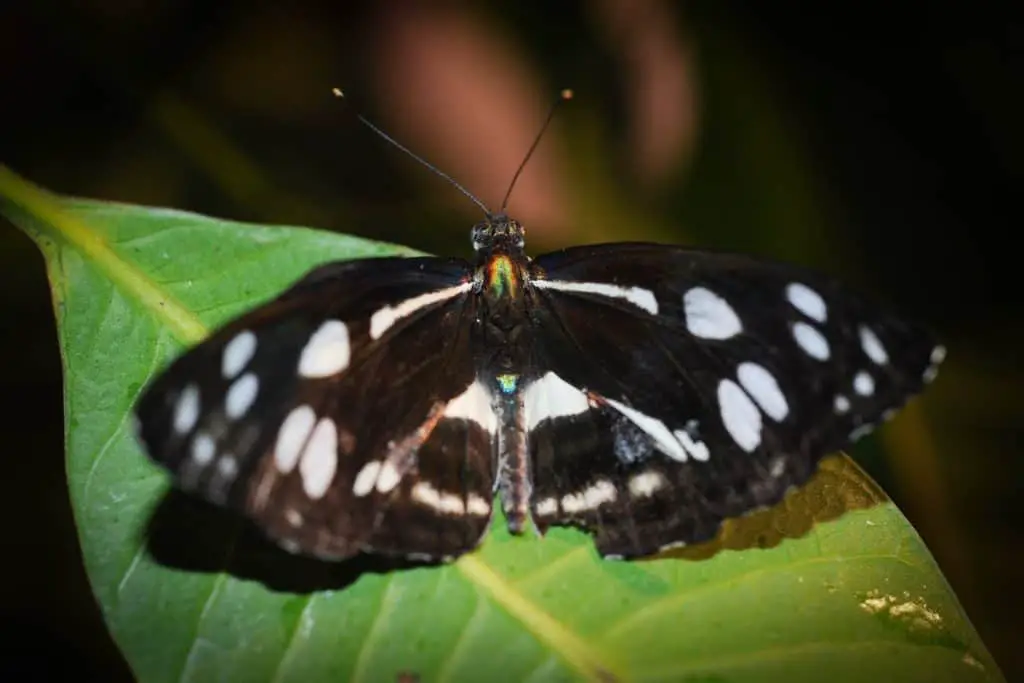During the day, we can often spot butterflies flitting among flowers and plants. But when the sun goes down, they seem to vanish without a trace. So where do butterflies actually go at night?
Butterflies are diurnal creatures, meaning they’re most active during the day. But at night, they must seek shelter from predators and other elements.
Butterflies typically roost in things like dense foliage, tree crevices, and even rock surfaces beginning at dusk until sunrise. In addition, some species of butterflies will also roost on man-made structures such as buildings and bridges.
Why Butterflies Roost At Night?
Now that we know where they roost, let’s take a look at why butterflies choose certain spots. For one thing, it’s all about conserving their energy!
Because butterflies are nocturnal, which means they are more active during the day so they need to rest “sleep” and conserve their energy at night.
This is especially important for migrating species that travel long distances.
Nighttime roosts also offer protection from things like predators and harsh weather conditions! In cold climates, butterflies may seek shelter inside trees or shrubs where temperatures remain relatively constant throughout the night.
Butterflies Roosting At Night Helps With The Following:
- Replenishes Their Energy Levels
- Offers Protection From Predators
- Provides A Safe Haven From The Weather
During extreme weather conditions like hurricanes and heavy rains, they’ll look for places with strong windbreaks to stay safe and dry.
Additionally, by resting in sheltered locations with limited exposure to wind or rain, they can conserve energy so they’re fully charged and ready to fly again in the morning.
Butterfly Roosting Behavior
So, let’s discuss the behavior of the butterfly roosting itself. While some species will sleep alone or in small groups of two or three individuals, others will join together with hundreds or even thousands of their own kind in what is known as a “roost”.
This is especially true for migratory species since the large numbers provide extra protection from predators while they rest before beginning their long journey again the next day.
If you came across a butterfly roosting at night it’s very common to find two or three varieties roosting together, as they benefit from being in larger numbers when it comes to protection from potential threats.
Related Article:

Do Butterflies Stay In The Same Spot All Night?
Believe it or not, butterflies do stay in the same spot throughout the night. Though they may be inactive and appear to be sleeping, they are actually conserving energy and being cautious of any potential threats.
It’s a natural instinct for a butterfly to remain in its spot when dusk falls, as any movement could make them susceptible to predators.
However, if there is a direct threat to their safety, such as another insect or arthropod, they will move away quickly in search of a safer location where they can spend the night peacefully and protected.
Even while seemingly stationary all night long, butterflies are constantly observing their environment and being aware of any danger that may arise.
Do Butterflies Ever Roost On The Ground At Night?
Despite preferring to hide in spots high up, butterflies are known to roost on the ground. They do so by seeking the protection of plant leaves on the ground at night.
While it may seem an unlikely resting place, the leafy shelter gives them some measure of protection from predators during their rest periods.
With that said, many butterflies have fallen prey to predators on the ground and even harsh weather conditions, so it’s not a preferred resting place.
Tips For Spotting Butterflies At Night
Spotting butterflies at night can be a tricky proposition, but with some patience and knowledge of their habits, it can be accomplished.
- First, you’ll want to look for roosts in trees and shrubs located near large sources of light like streetlamps or illuminated buildings. This will usually attract butterflies when they are looking for a place to rest for the night.
- When searching a tree or any other object with the potential for butterfly viewing, use a flashlight for a quick assessment “but” try not to disturb them too much.
- Move slowly with the light and inspect every branch and leaf – butterflies can often be seen resting on them.
- Lastly, be sure to remain quiet and patient – being too eager or loud may startle the butterflies in the area.
With these tips in mind, you should have no problem spotting butterflies at night.
Conclusion
So, now you know where butterflies go at night? it’s clear that there is much more to butterflies that meets the eye! From choosing sheltered spots for safety reasons or gathering in large numbers for protection during migration periods.
Related Articles:
